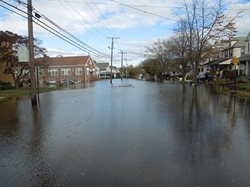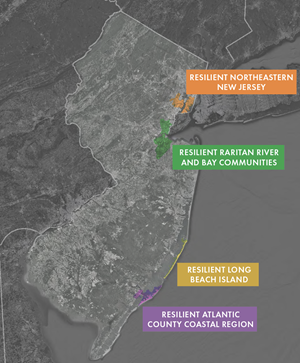
New Jersey is the sixth-fastest warming state in the country, with recent summer temperatures ranked as the third hottest on record since 1895. The Garden State is warming faster than the Northeast region, seeing an increase of 3.5 degrees in the observed temperature, compared with 1.5 degrees globally, in the last 120 years.
Those are some of the stark statistics from Nathaly Agosto Filión, deputy chief climate resilience officer in the state Department of Environmental Protection’s Office of Climate Resilience, during her presentation to the NJTPA Board of Trustees meeting on November 13.

Hurricane Sandy in 2012 “is really the moment in the history of our state where we started to become much more intentional in talking about climate impacts,” Filión said. It was also a time when federal mandates to address and prevent climate impacts were increasing.
The state’s efforts culminated in 2019 when Gov. Phil Murphy signed
Executive Order (EO) No. 89 establishing a statewide climate change resilience strategy. The EO created the position of state chief resilience officer, a climate and flood resilience program, and an interagency council on climate resiliency.
Filión is responsible for staffing and facilitating the work of the council which started with 17 agencies and now has 22 involved. The goal is to build resilient and healthy communities and protect the state’s ecosystem, among other priorities.
Based on the framework provided by the Governor’s EO, the NJDEP is preparing to release a Resilience Action Plan this coming spring focusing on extreme heat and steps to address it statewide – a number of which are already underway.
Among the tools available for resilience planning are:
- The New Jersey Flood Mapper allows users to zoom into their communities to see how they would be impacted in various scenarios, including sea level rise of 1-, 3- and 5- feet.
- The New Jersey Extreme Precipitation Project Tool provides users with an interactive map to identify regional and local estimates of projected changes in extreme rainfall under different scenarios.
- The Land Surface Temperature map shows surface temperature captured by satellite as proxy for heat.
Both Sustainable Jersey and Rutgers University have built upon the temperature tool, overlaying it with more information and data going down to the Census tract level, she said.

To assist in implementing resilient strategies, NJDEP created Resilient NJ, an assistance program to support local and regional climate resilience planning. Ongoing initiatives of Resilient NJ include a regional planning program across four regions (Northeastern New Jersey; Raritan River & Bay Communities; Long Beach Island; and, Atlantic County Coastal Region), a municipal assistance program in five municipalities, and another 15 more planned in 2024; and, an online toolkit for municipalities to conduct resilience planning on their own.
Using the tools, each region performs a Regional Risk Assessment on the impacts to critical facilities and assets based on future expected climate conditions. Looking at what would happen if a Sandy-like storm hit the state in 2070, the four regions would likely see some $45 billion in damages. By comparison, the entire state suffered $30 billion in damages after Hurricane Sandy, Filión said.
A recording of the presentation is
here.